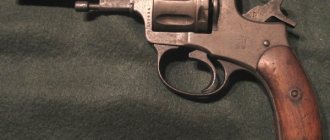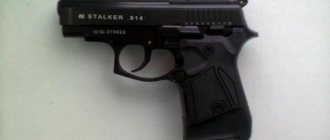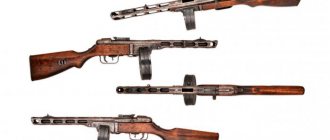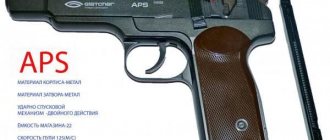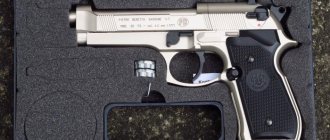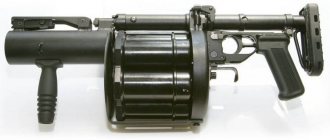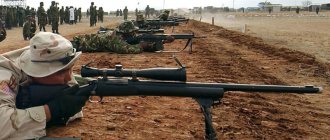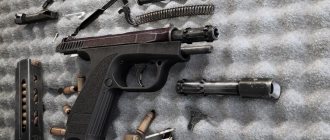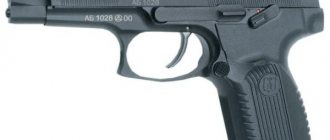Modern design solutions are sometimes very simple. One of them is a principle that does not imply the creation of new weapons, but the modernization of existing models that have proven themselves well. One of the favorite pistols, which has been experimented with for decades, is the PM (Makarov pistol). It has been in service with the Russian army and intelligence services since 1951. Despite the fact that it was developed back in Soviet times, its combat and operational characteristics are still in demand today. Moreover, progress does not stand still, and new developments based on it take into account the experience of not only domestic, but also foreign gunsmiths. A classic example of such a weapon is the IZH-71 service pistol, developed on the basis of the PM.
History of creation
The IZH-71 pistol was developed by designers of the Izhevsk Arms Plant based on the PM in 1994. Everything original is simple - it is a remake of the above-mentioned PM chambered for the Browning cartridge, which is accepted as standard in a number of European countries (Sweden, Italy, Czech Republic). This automatically implied the possibility of selling the pistol for export. But the initial task that the designers set for themselves was to create a service pistol for employees of private security agencies. The requirements for this type of weapon differ from combat weapons. It is used to protect natural resources, private property, life and health of other people.
And the IZH-71 pistol, whose characteristics roughly correspond to the PM, really met the necessary conditions. However, in 2006, the government attempted to remove him from the security structures. The reason for this was that, according to the Federal Weapons Law, weapons used by state paramilitary structures cannot be in service with private security companies. And the IZH-71 pistol was adopted by the Federal Bailiff Service. Despite these problems, the pistol still serves various security agencies and companies regularly. In this field of activity he has proven himself more than good.
Variations and modifications
One way or another, IzhMekh released three versions of the pistol to the market, which are still in use:
- Izh-71/071-101 – the first production model;
- Izh-71/071102 – version with a 10-round magazine;
- Izh-71 N/071-103 – model with an extended magazine for 12 rounds.
It is worth considering that since 2008 the marking has changed to “MR”.
Rare types of Izh-71
The linear sample is produced in large quantities. However, there is a variant of the weapon with the Izh-71 100 index, which differs from the base model in a modified handle and a two-row magazine for 11 rounds. They produced it in a small batch for export sale, but something went wrong and production was stopped. Later, some of the samples were used to make a mass-dimensional model, which is valued by collectors. A total of 6 such models are known.
Weight and size models
Products that have exhausted their service life are returned to IzhMekh for recycling. There, most of them are sent for remelting, and from the best preserved ones, Izh-71 SHP is assembled. Simply put, it is a deactivated version of the pistol that fires blank cartridges. MMGs are often bought by collectors or used for filming TV series and movies. Permission to purchase agricultural products is not required, and they are freely sold to ordinary people.
Modernization
To compete in the service weapons market, IzhMekh had to work on improving its weapons. No changes were made. The matter was limited only to the expansion of the regular store. The rest remains the same.
Advantages of a pistol
Like any other weapon, the IZH-71 pistol, the design of which is approximately the same as the PM pistol, has its advantages. And the advantages of these two pistols are almost the same. The pistol is reliable and convenient, it can easily be brought into a firing position. This is facilitated by a special self-cocking - the first shot can be fired without first cocking the hammer. In addition, it is distinguished by its simplicity of design, low weight, and small size. All this allows you to comfortably wear it under clothes. Also externally it is almost impossible to distinguish it from PM.
With all this, the IZH-71 still has differences from the Makarov pistol. First and foremost is the type of cartridge used, but there are also smaller differences. It has a lower muzzle velocity, which meets the requirements for security weapons. It must have restrictions that relate to firing range, caliber, and damaging factor. The characteristics of IZH-71 are almost the same as PM, which allows it to be used more effectively.
About the disadvantages of weapons
The fact that the IZH 71 is a completely reliable weapon has, in general, already been said. It also has some disadvantages. Actually, there is only one specific, that is, inherent exclusively in service IL 71, drawback.
The pistol uses 9x17K cartridges. And although they are considered weaker compared to charges of the 9x18PM type, however, as many experts testify, their effect on the target is almost the same. In this connection, the question arises as to why it was necessary to purchase technological equipment abroad for the production of 9x17K cartridges. Moreover, in Russia they produce the 9x18 PSO cartridge, which, according to experts, can be easily and cheaply adapted for firing from the IZH 71, only slightly changing its thickness.
However, this is more about economics and politics than about the actual conversation about the advantages and disadvantages of a particular type of weapon.
How the gun works
The automatic weapon operates on the principle of recoil of a free bolt, which is not engaged with the barrel. However, when firing, the bolt reliably locks the barrel due to its large mass and strong return spring.
The design of the firing mechanism, as already mentioned, allows you to immediately open fire by pressing the trigger. This is possible thanks to a trigger-type mechanism.
History[edit]
During the Second World War, many different, maximally simplified types of weapons and equipment were used. Armored firing points (BOTs), used for the defense of large cities or important areas, have become quite widespread. Along with stationary bots, there were also mobile (towed) bots that could be transported from one position to another.
The creator of this fire armored trailer is the commander of the 72nd machine gun and artillery battalion, Georgy Vodopyanov, an experienced engineer in the reconstruction department with the civil and Finnish wars behind him. The battalion was formed on August 21, 1941 from workers of the Izhora plant.
Some work to strengthen the battalion was also carried out by the workers who were part of the 72nd OPAB. Under the leadership of Vodopyanov, a very interesting design was created, which was not included in the summary of the activities of the Izhora plant. The predecessor of the IZH-72 was a trolley using the turret of a T-38 tank destroyed in battles, and the turret was welded to accommodate a machine gun, and the chassis was a welded structure with wheels from a cannon. A horse was used for transportation. These structures were a necessary measure in order to strengthen the battalion's anti-tank defense.
In the spring of 1943, the 72nd OPAB, under the command of Vodopyanov, already with the rank of major, took part in battles, as a result of which the enemy was thrown back from Kolpino. Based on the results of the battles, Georgy Veniaminovich, already at the rank of lieutenant colonel, came to the conclusion that the firepower of the firing point created under his leadership was not enough. Therefore, the development of a more powerful firing point began - the IZH-72 BOT. The concept of this design repeated the previous development, but it was larger. Unlike the previous development, a detailed description and test report have been preserved.
Instead of the T-38 turret, this time a conical turret from the T-26 light tank was used. As a matter of fact, it was the presence of turrets from this tank on the 14th UR (which was subordinate to the 55th Army) that prompted Vodopyanov to create a more powerful firing point. According to Vodopyanov himself, he saw the purpose of IZH-72 as follows:
- Use as a mobile artillery point with bulletproof and anti-fragmentation protection to create strongholds in a field missile defense system.
- Escorting convoys during an offensive, as a means of anti-tank and air defense.
- Security of headquarters and rear areas.
As an additional argument in favor of such a design, the conclusion of the 14th UR Colonel M.D. was used. Bezperstova. At that time, the 72nd OPAB was part of this fortified area, this largely explains the appearance of IZH-72: “Based on the experience of combat operations of field forces of the UR in the Patriotic War to consolidate the lines captured from the enemy and create strong anti-tank stations on them in parts of UR-a it was necessary to create engineering structures for artillery crews in a short time. However, the close proximity to the enemy’s front line and the impact of his fire creates great difficulties in the construction of engineering structures in the form of bunkers that have at least bulletproof and anti-fragmentation protection. The action of artillery crews from open positions entails large losses in artillery crews due to enemy machine-gun and mortar fire. The delivery and installation of existing models of BOT for anti-tank guns in close proximity to the enemy is not very realistic. The design of a mobile armored artillery point proposed by Lieutenant Colonel Comrade Vodopyanov positively resolves the issue of installing in strong points, in close proximity to the enemy, anti-tank weapons that have armored anti-fragmentation and bulletproof protection for the crew. The ability to move this point by means of vehicles allows field forces of the SD to quickly create fortified areas by installing these points in pre-dug and camouflaged niches in places where strong points are organized. At the same time, this design of the tank makes it possible to transfer these anti-tank weapons along the front as the situation demands, to strengthen the desired tank-hazardous area as a mobile anti-tank weapon. The armament of the IZH-72 on board makes it possible to fight enemy tanks, infantry and aircraft. Due to the above, I believe that the production of mobile IZH-72 BOTs is rational, since in terms of tactical value they can be used:
1) In service with troops of field fortified areas in their use when organizing strong points when securing lines captured from the enemy by field troops, where the IZH-72 BOT, being a means of anti-tank missile defense, simultaneously performs anti-aircraft and anti-personnel defense. They acquire particular importance in the defense of populated areas.
2) In convoys of formations during the advance of our troops as a means of escort for organizing anti-tank and air defense instead of escort tanks. To protect headquarters and their rear as a means of anti-tank and air defense.”
The prototype IZH-72 was delivered on December 2, 1943 to ANIOP. When examining the body, fatigue cracks were discovered that had formed during welding. For this reason, the BOT was temporarily removed from testing, sent to the 72nd OPAB, and the malfunctions were eliminated. On December 6, the tests resumed, with Vodopyanov himself and crews from the 72nd OPAB taking part in them. Tests showed quite satisfactory fire accuracy, comparable to a conventional T-26 tank. The main criticism was the insufficient strength of the rear wheel axle. During transportation tests, the left end of the axle bent by 9 mm and the right end by 4 mm. This unit was supposed to be strengthened. Also, tests with a cart behind a truck showed that the ZIS-5 was driving with an increased load. In general, the IZH-72 performed quite satisfactorily; the conclusion indicated that this design could be approved for military testing.
These tests, however, did not take place. In January 1944, a letter came from the Artcom of the GAU KA in which its chairman, Lieutenant General V.I. Khokhlov gave instructions to stop work on IZH-72. The arguments were more than fair. The T-26 turret, both in terms of weapon characteristics and protection characteristics, has been outdated for many years. In addition, just at this very time, tests were underway of a similar firing system PAOT-76, which was even adopted for service as the PD-76. Against this background, the initiative of the commander of the 72nd OPAB looked clearly outdated.
Pistol IZH-71. Device
Structurally, the weapon consists of the following parts:
— the pistol frame includes a barrel and trigger guard;
- a bolt, the design of which also includes an ejector, a firing pin and a fuse;
— firing mechanism;
— return spring;
- handle and screw;
- shop;
- shutter stop.
In addition, the standard equipment of the pistol includes a spare magazine, a pistol belt and a holster, and a wiper.
Construction[edit]
Hull and armor[edit]
IZH-72 had a conical turret from the T-26 tank of the 1938 model with additional 15 mm armor plates. The turret was mounted on a biaxial trolley welded from 10 mm armor steel. For the body, axles from a 3-ton trailer with wheels from GAZ-AA were used. The turret housed a crew of two. The combat weight of the IZH-72 was 3560 kg. In total, the IZH-72 crew consisted of four people - the turret crew, as well as two ammunition carriers.
Weapons[edit]
The main armament consisted of a 45-mm 20-K cannon mounted in the turret of a T-26 light tank, with 100 rounds of ammunition (60 armor-piercing and 40 high-explosive fragmentation shells). As additional weapons, the turret had a pair of two 7.62-mm DT anti-aircraft machine guns mounted on a swivel, with an ammunition supply of 60 discs of cartridges.
Engine and transmission[edit]
The development did not have its own engine. A ZIS-5 truck was used as a means of transporting IZH-72.
Chassis[edit]
The running gear was 2 axles from a 3-ton trailer with wheels from GAZ-AA. Wheels 6.5-20″ model I-4. Single busbar.
How the weapon functions
To fire a shot, you need to press the trigger with your finger. In this case, the trigger hits the firing pin, which breaks the cartridge primer. Because of this, the main powder charge ignites, and the bullet leaves the barrel under the influence of powder gases.
The same gases, escaping from the bottom of the sleeve, affect the bolt. It moves back, while compressing the return spring and engaging the sleeve with the ejector. Along the path of the bolt, the reflector throws the spent cartridge through a special window in the bolt. When the bolt reaches the rearmost position, he turns the trigger on the trunnions and cocks it again. Then the return spring begins to expand and moves the bolt forward. As it moves, the rammer engages the next cartridge and enters the chamber. All parts are returned to their original position and the gun is ready to fire again.
To shoot again, you need to release the trigger and then press it again. Thus, firing from the Izh-71 pistol is carried out until the magazine runs out of cartridges. After this, the shutter is delayed and remains in the rearmost position until reloading.
Summing up
To summarize, it should be said that today the IZH 71 pistol is the most common and sought-after weapon in Russian private security units. The characteristics of the pistol are of considerable importance here, as well as the fact that it is almost indistinguishable from the PM.
His external identity with “Makarov” is an additional psychological tool that has a very good effect on an attacker trying to penetrate a protected facility.
Weapon maintenance and care
Like any other mechanism, the gun needs to be cleaned and lubricated regularly. Failure to follow these procedures may cause the pistol to malfunction and cause delays or misfires when firing.
One of the mandatory conditions for care is disassembling the weapon. In the case of IZH-71, this is especially true. The IZH-71 pistol, although its characteristics remain at a high level, still requires maintenance. You can carry out both complete and incomplete disassembly. The first type is intended for cleaning weapons if they are heavily soiled and exposed to rain and snow. Also, complete disassembly must be done for lubrication and repair. But you need to remember that such a procedure is often not recommended, as this wears out the parts of the product.
Partial disassembly of the IZH-71 pistol is necessary for lubrication, cleaning and inspection of the pistol. In both cases, certain conditions are required for implementation - a clean surface (bench, table) or at least bedding. When disassembling, the parts are laid out in the order they were removed and must be handled with care and avoid being dropped or bumped. You also need to follow the numbering so as not to confuse them with parts of another pistol.
The procedure for partially disassembling the pistol:
— removing the magazine from the handle;
— separation of the bolt from the pistol frame;
— removing the return spring from the barrel.
The pistol is reassembled in the reverse order. After it is implemented, it is necessary to check its correctness. An incorrectly assembled pistol can be a threat not only to other people, but primarily to its owner. Therefore, after the pistol has been assembled, the following steps are performed - the safety is turned off by moving its flag down. After this, the shutter is automatically set to the shutter delay. It is turned off, and the shutter returns to its normal position. The trigger must remain cocked. Then the fuse is turned on. In this case, the trigger should immediately break from the firing position and lock. If this doesn't happen. the weapon is assembled incorrectly and requires repeated assembly and disassembly.
